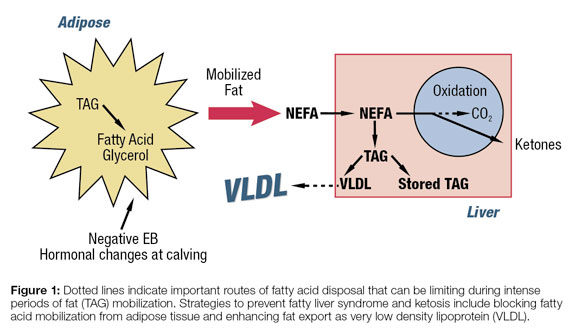Etiology of fatty liver and ketosis Fatty liver syndrome and ketosis are metabolic disorders that result from intense fat mobilization during hormonal changes and negative energy balance associated with the transition period. The liver is an extremely important metabolic organ in transition dairy cows.
It plays a central role in controlling energy metabolism, hormonal status, detoxification of harmful compounds, immune responsiveness and reproductive function. Livers can become engorged with fat when there is an increase in the uptake of fatty acids from blood ( Figure 1 ).

Uptake of fatty acids by the liver is related to the amount of blood that flows to the liver as well as the concentration of fatty acids in the blood. Both are increased starting shortly before calving and blood concentrations may remain high until the cow reaches positive energy balance.
*Figure notes*: Dotted lines indicate important routes of fatty acid disposal that can be limiting during intense periods of fat (TAG) mobilization. Strategies to prevent fatty liver syndrome and ketosis include blocking fatty acid mobilization from adipose tissue and enhancing fat export as very low density lipoprotein (VLDL).
During this period of high blood fatty acid concentration, the liver cannot keep up with its “normal” metabolism of fatty acids and the cow develops fatty liver and potentially subclinical or clinical ketosis. The “normal” metabolism in the dairy cow is not really normal in relation to most other animals.
Ruminants have an inherent deficiency in their ability to process fatty acids and export them as fat within a very low-density lipoprotein to other tissues such as the mammary gland.
Strategies to prevent fatty liver and ketosis focus on limiting fatty acid mobilization from adipose tissue or increasing the rate of fat export out of the liver. Limiting fatty acid mobilization can be achieved by enhancing the energy balance of the cow or by “chemically” blocking mobilization.
In general, attempts to enhance the energy balance of the cow have usually been through modification of the basal diet ingredients or addition of ionophores to increase the efficiency of dietary energy use. Chemical blockage of mobilization is usually accomplished by addition of antilipolytic feed additives.
The latter strategy is not favored because it fights “Mother Nature.” Fatty acid mobilization is part of a natural process to support lactation. Why would we want to limit it, especially if one could increase export of fat from the liver?
Fat export from the liver is a favorable strategy because it enables delivery of fatty acids to the mammary gland (and other tissues), where they can be used as an energy sources or for synthesis of milk fat.
Management of fatty liver syndrome and ketosis by modification of the basal diet
- Close-up (usually three-week pre-fresh to calving) diet: Increased concentrate feeding during the close-up period has been the most studied strategy to improve animal health after calving. Results from eight relatively recent studies that examined decreasing the forage-concentrate ratio (increasing non-forage carbohydrate, NFC) of close-up diets were recently summarized.
In each study, cows were fed treatments prepartum and were switched to a common diet postpartum. Prepartum dry matter intake (DMI) was significantly increased in five of seven studies when NFC was increased.
A few studies showed a transient increase in DMI immediately postcalving; however, none of the studies reported a beneficial effect when DMI or milk yield were measured over a longer duration (4-10 weeks). In most of these studies, energy balance was not reported. However, if postpartum DMI and milk yields were not affected, it is unlikely that energy balance would have been affected.
These studies did not employ enough animals to determine treatment effects on health disorders. Nevertheless, it is unlikely animal health would have been affected without changes in DMI, milk yield or both.
Similarly, a summary of other feeding strategies also indicated minor effects on metabolic parameters and postpartum performance. In three studies, forage NDF was replaced with nonforage NDF; and in three studies, feed was restricted to limit energy intake.
These studies, in combination with the studies on altering forage-to-concentrate ratio, provide evidence that close-up diets may have less effect on postpartum cow health and performance than previously thought.
- Far-off dry cow diets: Based on results from Dann et. al., it was suggested that nutrition of the far-off dry cow may have a greater impact on animal health than the close-up dry cow. In that study, energy restriction during the far-off period resulted in modest reductions in postpartum liver fat and blood beta-hydroxybutyrate, but lactation performance was not affected.
Silva-del-Rio also showed modest decreases in liver fat and beta-hydroxybutyrate when feeding diets with .60 vs .70 Mcal NEl per lb dry matter during the far-off dry period. However, cows fed the higher-energy-density diet produced significantly more milk postpartum (+11.4 lbs per day for the 10-week monitoring period). Conflicting results from only two studies suggest further research is needed.
- Diets fed for the entire dry period: While the number of trials specifically examining the far-off dry period is limited, six studies have examined altering energy intake for the entire dry period, and results were recently summarized. The most consistent effect was a modest reduction in blood NEFA due to energy restriction (observed in four of the five studies in which it was measured; range = .10 to .15 mEq/L).
However, there were no positive effects of energy restriction on postpartum milk yield and in only one study was there a positive effect on postpartum DMI. These studies did not include sufficient numbers to assess effects on animal health. However, if it was improved, it was not reflected in improvements in lactation performance.
Management of fatty liver syndrome and ketosis via feed additives
Since the greatest rate of fat mobilization and infiltration into the liver occurs about the time of calving, strategies for prevention of fatty liver and ketosis should commence during the prepartum period. As described above, alteration of the basal diet during the dry period may have limited potential to alleviate fatty liver and ketosis.
Incorporation of feed additives into the diet may be a useful strategy. Monensin has been reviewed by others and will not be covered here, other than to say supplementation has been shown to lower blood ketones, but not liver TG.
As previously mentioned, an additive that enhances fat export out of the liver is preferred to one that chemically blocks lipid mobilization, because it facilitates rather than inhibits a normal physiological process that supports lactation.
Choline is the only feed additive with evidence that it enhances fat export from the liver and reduces fatty liver and ketosis during the transition period. Estimates of ruminal choline degradation are high and ruminal production of choline is negligible. Therefore, if choline is fed, it must be in a form that is protected from ruminal degradation.
Feeding 15 g choline per day in a ruminally protected form prevented induction of fatty liver and alleviated fatty liver following induction when feed-restricted dry cows were used as the model. More recently, this same dose of protected choline was fed to dairy cows from 21 days prepartum to six weeks postpartum and reduced liver TG during week one and week three postpartum.
To evaluate effects on animal health parameters such as ketosis, trials employing large animal numbers are required and need to be conducted on large commercial farms. Santos et. al. conducted two experiments on separate farms.
On one farm (363 cows), 0 or 15 g per day of choline in a protected form was fed between 25 days prior to expected calving until 80 days postcalving. Postpartum, DMI tended to be greater (52.6 vs. 49.8 lbs per day) and fat-corrected milk yield was greater (98.2 vs. 94.3 lbs per day) for cows fed choline.
Feeding choline reduced the incidence of subclinical ketosis (10.7 vs. 28.8 percent), clinical ketosis (4.0 vs. 11.3 percent), relapse of clinical ketosis (2.3 vs. 6.85 percent) and cows with liver fat greater than 5 percent wet weight (14.3 vs. 40.0 percent).
On the second farm, the same treatments were fed only to heifers and the duration of treatment was only from 25 days prior to expected calving until calving. DMI and fat-corrected milk were not affected by treatment and choline supplementation tended to increase milk yield (63.2 vs. 61.5 lbs per day).
Parameters related to ketosis were not affected by treatment. The absence of a response on the second farm may have been due to the absence of choline supplementation after calving, the use of heifers (which are less susceptible to fatty liver and ketosis), or both.
Finally, if feeding ruminally protected choline during the transition period improves liver and cow health, then one should expect to see an improvement in lactation performance. Six of seven transition cow studies have indicated there was a significant increase for either milk yield or milk yield corrected for energy content.
Summary
Altering basal ingredients of dry cow diets may be less effective at improving postpartum health and production than previously thought. Feed additives, such as ionophores or ruminally protected choline, that increase feed efficiency or help transport fat out of the liver, can reduce the likelihood of fatty liver, ketosis or both and potentially enhance the performance of lactating cows. PD
Grummer is also an emeritus professor from the University of Wisconsin – Madison.
References omitted due to space but are available upon request to editor@progressivedairy.com .

-
Ric Grummer
- Ruminant Technical Manager
- Balchem Corp.
- Email Ric Grummer








